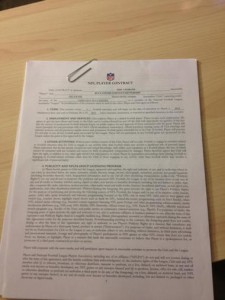After the conclusion of the Super Bowl every year, team executives immediately put into place their plans to reach the pinnacle in the next season. Similarly, fans get excited for the opportunity for their team to start anew. The roster is adjusted and tweaked continually through numerous player management methods. This process begins in February and continues right up to (and into) the regular season.
While the media tends to focus on adding players through free agency and the NFL Draft, teams sometimes need to first address their shortcomings through a process of addition by subtraction. Teams can always choose to not re-sign players whose contracts are expiring, but what about those players a team no longer wants that are still under contract? What options exist for removing those players from the roster?
 Give Me a Reason
Give Me a Reason
There are multiple reasons a team may want to move on from a player still under contract. Proven veteran starters, many of whom are extremely popular with fans, easily fall into this category. This year is no different as players such as Packers safety Charles Woodson, Giants running back Ahmad Bradshaw, Jets linebacker Bart Scott, and Bills linebacker Nick Barnett have already been released.
VALUE
The primary reason to remove a player from the roster is because the player is not worth his cap charge. The team likely still values him and even wants him to remain on the team, but they cannot afford his current cap charge. He might still be worth his base salary, but a player’s cap charge can be much higher due to prorated dollars as a result of his contract structure.
Personally, I am an advocate of the ‘pay-as-you-go’ approach which structures a contract more on a year-by-year basis. With this strategy, the bonuses utilized count in the year earned, instead of prorating the dollars and pushing money into future years. Certain teams do a better job of this than others, and I admire a team that negotiates a contract that may count for more on the current year’s salary cap while limiting the liability on future year’s salary caps.
However, teams have not always historically decided that the most prudent decision was to build contracts with a ‘pay-as-you-go’ structure. Sometimes a ‘credit card’ approach is utilized. But maybe:
- The team wanted to add a lot of veteran players that year.
- The team felt that a specific off-season had more quality talent available than usual.
- The team applied a franchise tag to a player (chewing up a large chunk of cap space).
- Bonus pro-ration from previous year’s contracts was significant.
- Agents were refusing certain ‘team friendly’ contract structures.
- The team just likes the ‘credit card’ approach.
Regardless of the reason(s), sometimes teams decide to take a cap strategy that builds contracts with bonus dollars spread across the life of the contract. If enough of these contracts exist, salary caps in future years can be handicapped. For instance, assume that two quality free agents sign multi-year deals with Team A every off-season. If even one million of bonus pro-ration counts in each year of each of these player’s contracts, by the fourth year of this approach, $6 million dollars has been allocated to the salary cap for year four (2 players times 3 years times $1 million). This is money above and beyond the player’s salary for year four, and it is money that cannot be used in year four for player acquisition. Millions of dollars add up fast. Consequently, as these teams approach the new League Year (thereby applying a cap that was previously “in the future”) they can be forced to be active in February to be under the salary cap. So how do teams plan for these February ‘adjustments?’
 The Science of a Contract
The Science of a Contract
Teams often build logic into their contract signings. Sometimes teams sign a player to a contract fully anticipating the player to play out his contract, achieving the dollar value paid to him in each year of his contract. He becomes expendable when for whatever reason he does not play up to the expected standard. Other times teams build a contract such that only a set number of years will actually be played for the team. Teams can add “dummy years” that easily void onto the end of the contract. This type of contract can help to lesson the current year’s cap charge by pushing more pro-rated bonus dollars into those “dummy years.” For example, a $6 million bonus on 3-year contract counts for $2 million per year on the salary cap. If an extra 2 “dummy years” are included, the pro-ration per year reduces to $1.2 million.
Another technique that is often used is for a contract to have an early March roster bonus worth millions of dollars built into the third or fourth year of the contract. This roster bonus exists in addition to the player’s base salary and sets the stage for a team decision. Either they value him enough that they deem it worthy to keep him on the team and pay his March bonus, or they do not believe he is worth the extra millions and they inform him that they will be releasing him prior to the March date. Teams like these contracts because the roster bonus payments are not guaranteed until the March date, and players like these contracts because they have a multi-million dollar payment coming their way OR are guaranteed the ability to test the free agent market. The later the date in March, the better for the team to have seen their free agency plan work or not. With an early March date, the player will need to be released prior to the start of free agency (which allows him full accessibility to the start of free agency and more potential suitors).
AGE
There comes a point for every athlete when age catches up with him. This is when strength, speed, etc… have diminished to a point that cannot be overlooked. Teams try to stay ahead of this curve by having player contracts end before they reach this point. But nobody can accurately predict the future, so some players play well years beyond what is normal for a player at his position (e.g. Falcons tight end Tony Gonzalez), and others fall off sooner than expected. If a player is still under contract when his decline becomes evident, then it becomes necessary to address his contract or release him.
INJURY
Some players are more prone to injury than others. Some even become chronically injured. Sometimes it is genetic, sometimes it is due to a lack of proper training or laziness with physical preparation, and sometimes it is simply a result of the physicality of the sport having finally taken its’ toll on the body. The older a player gets, the more he MUST pay attention to his body, especially once he gets into his 30’s. Otherwise, he is likely to end up in the training room often. Teams have very little tolerance for players that miss practices and games, especially if they are not premier players. After all, what organization wants to pay an employee that doesn’t produce?! In sports, players are paid to play. Regardless of the reason, a recurring injury or the combination of numerous small injuries are enough to make a team decide to part ways with a player.
CHARACTER
Some players become more problematic than productive. The media is quick to report incidents dealing with the law, but sometimes a character issue is much less public than that. Some players become “locker room lawyers” petitioning for a team or its’ management to change its’ ways. Some players constantly voice how they are mistreated or underpaid. Some even go so far as to say the team is no good and/or state that he doesn’t want to be there. (I have experienced this.) These players can quickly become cancers, and like any form of cancer, it can spread. Three, four, or more of these players on one roster will rip a team apart from the inside out, no matter who the coaches are. So teams know the value of keeping these players in check or getting them rid of them before they become a huge problem.
 Planning for March
Planning for March
Teams know what their salary cap situation is heading into the new League Year, and those teams that will exceed the salary cap know that they need to act quickly. Teams MUST be under their salary cap when the new League Year starts in early March (the new 2013 League Year begins on March 12), or they face League action. The penalty is immediate and swift, as the League Office removes players from the roster to get the team under the cap, accompanied by fines on the team. Teams avoid this situation by always making sure to be under the cap by the start of the new League Year, and that is why February can be busy. So if a team is over the cap in February, how exactly can it get proactive to be under the cap by March? And what options does a team have to remove players currently on the roster that are paid more than their value?
I will answer those questions in next week’s segment by documenting the options that teams weigh, along with the pros and cons. In the interim, I encourage your comments.
I will answer that question in next week’s segment by documenting the options that teams weigh and how those options play out. In the interim, I encourage your comments. Make sure to follow Sports Networker via our Facebook page and Twitter account @SportsNetworker



Pretty great post. I simply stumbled upon your weblog and wished to say that I have really loved browsing your weblog posts. In any case I’ll be subscribing to your rss feed and I hope you write once more soon!
Thanks for your compliments, and I’m glad you enjoy my writing! I post a new article every Friday for your reading pleasure.